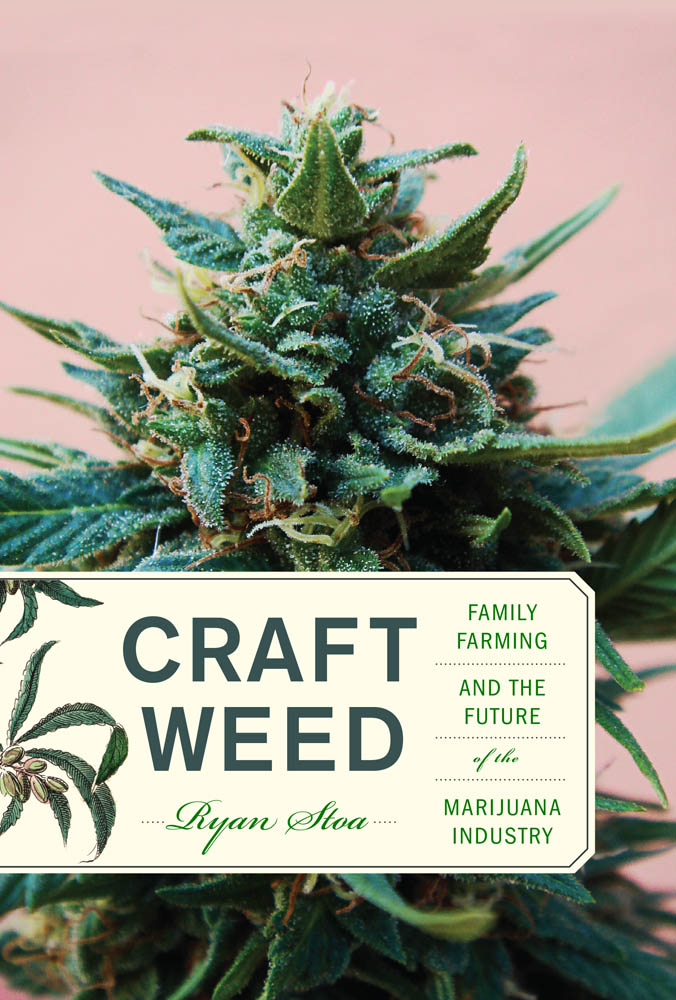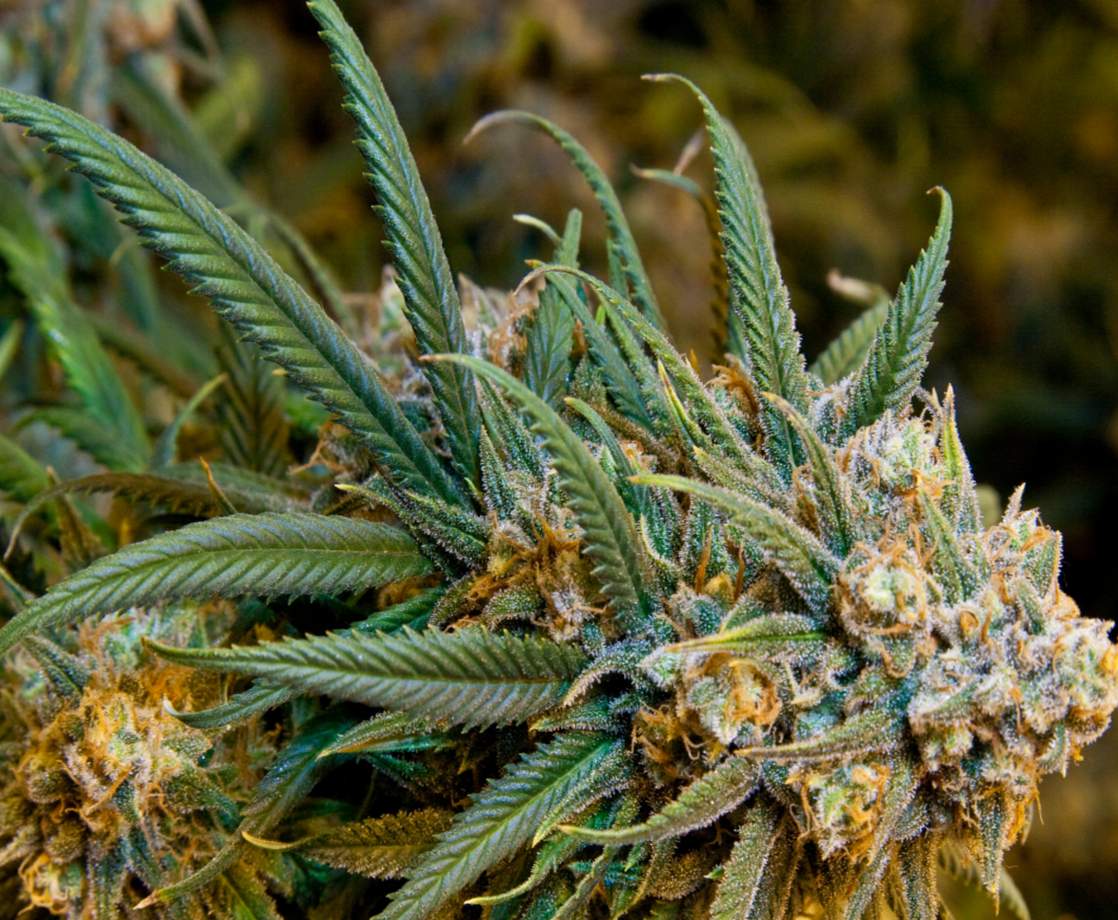Lead photo via iStock
Legal marijuana has arrived in many parts of the U.S., and many believe it’s only a matter of time before the federal government lifts prohibition. Yet, as the market expands, there remains a good deal of uncertainty as to whether everyone currently in the cannabis industry will remain competitive.
Amidst concerns about the imminent takeover of corporate weed in legal markets, and the toll of such actions on small cannabis farmers, Ryan Stoa has taken an optimistic stance in his new book Craft Weed: Family Farming and the Future of the Marijuana Industry. An associate professor at Concordia University School of Law, Stoa argues that the future of the cannabis industry should be powered by small-scale farms, akin to the craft beer or wine industries. To get the scoop on Stoa’s perspective, we interviewed him about his research process, predictions for the future, and his confidence in the small farmer to bring balance to legal cannabis.

Photo courtesy of MIT Press
This interview has been edited for length and clarity.
MERRY JANE: What prompted you to write this book?
Ryan Stoa: There’s this idea that with legalization will come the commodification or corporatization of the marijuana industry, and not only that, but that the process is inevitable. You see headlines like that all over the place: “Big marijuana is upon us” or “Brace yourself, big marijuana is here.” These articles have some merit; there’s money pouring into industry with legalization. And once federal prohibition is lifted, there will be more investment opportunities.
What I’m pushing back on is the idea that a corporate takeover is inevitable. There is still [room for] the artisanal producers, small-scale family farmers; the type of farmers that made the American marijuana industry what it is today. Many of them already exist and are out there producing really high quality products. I argue that there’s a strong role for them to play in the marijuana industry of the future — that this can happen despite whatever corporatization occurs.
Why do you have faith that these smaller players can survive in a business environment with corporate cannabis?
I wouldn’t say it’s a guarantee that everyone will survive. As things change, folks will have to adapt to the demands of the industry. I do think that there will be a role for craft producers or small-scale family farmers. Number one: there’s already a lot of them out there. In California alone, there are at least 50,000 marijuana farms. Compare that with the state’s minimum 3,000 wineries. There’s already a large community of farmers, [who are] for the most part are organizing and being active in their communities and local political infrastructures. They’re taking steps to make sure they have a future, and many local governments have incentives to protect rural economies. You see this especially in northern California — Humboldt, Mendocino counties. Those local politicians are aware of the importance of marijuana farming in their region; they want to take steps to help protect those local farmers.
Federal prohibition still prohibits the interstate commerce of marijuana, [though] of course there’s still black market transactions taking place across state lines. But as far as legal markets go, which are growing everyday, the only producers that legally provide the supply are producers in-state — which means we’re seeing a rise of marijuana farming across the country. In states where there’s legalization, there’s a growing diversity of farmers and farming regions.
What about on the East Coast, in states like New York, or even as far as Illinois, where medical cannabis programs are more tightly regulated, where the climate doesn’t encourage outdoor grows, or where there’s not the same heritage of small-scale farmers, like in northern California?
I think the key in those states is to emphasize that governments have a choice in the matter. They have a role to play in choosing what the farming culture will look like in their marijuana industry. You can see different models of that. Some states are putting a cap on acreage limits or canopy size. You have your permit or license which only allows you to grow one or two acres of marijuana. And in other states, they’ve taken the complete opposite approach.
In Florida, for example, through their marijuana infrastructure, they essentially chose business organizations to be the legal suppliers for the entire state, and there’s some advantage to that from the government perspective or regulatory perspective — there’s only six communities you need to keep your eye on, but it doesn’t allow very many citizens to enjoy the industry. [States] could set up producer licensing schemes that promote consolidation, with large entities being the sole suppliers, so states need to think about what they want. But I think you’ll see a solid trend at least out West: states realizing that if we’re going to legalize marijuana, the benefits [should] be shared across the population and there should be economic opportunities for all growers.
What are the disadvantages that small farmers face in a corporate-dominated legal cannabis market?
The big marijuana model will allow a few big players to produce very cheap marijuana in a generic form. Because they’re growing on such a massive scale, they’ll be able to grow it at an extremely low price and flood the market. That will drive family farming operations out of business, because they won’t be able to sell their marijuana for as low a price. I think the other concern is that there might be some environmental cost to the widespread, large-scale marijuana farming operations as opposed to the smaller-scale family farming model.
If these small growers survive, should there still be a model for corporate cannabis anyway?
I’m not guaranteeing that these small-scale farmers will survive. There’s work to do. We need to continue to advocate on their behalf. Consumers need to recognize the costs and benefits of the artisanal model versus the corporate model. Politicians need to think about what type of industry they want to see and what kind of agricultural community they can promote. I don’t think it’s a given. That was my motivation for writing this book. We need to make that decision and take steps to promote it.
Is there still a role for big marijuana players? No doubt they will occupy a certain space. What the large producers can bring to the table is a sort of inexpensive, generic marijuana that many consumers might still find attractive. If we as a society are recognizing that marijuana has medical, therapeutic, and spiritual benefits, then I think there’s value in being able to provide marijuana products at a cost that’s affordable for everyone. If you think about a really large warehouse grow or a few thousand acres growing pound after pound of generic marijuana, they’ll flood the market. That might not be such a bad thing for some consumers. The key is to balance that with some protections for family farmers, and policies that allow artisanal producers to thrive alongside that [corporate] model.

Professor Ryan Stoa, photo courtesy of MIT Press
So the idea is that with buying power or legislative power, there’s still room to craft what this industry could allow in terms of small vs. large farms?
We bemoan the state of agriculture in the U.S., which could be hard to change [since] we have interests that are already entrenched. We recognize that we’re ushering in a new billion dollar industry, and it’s a unique opportunity to craft and form the type of industry and agricultural community that we really want — an agricultural community that really reflects our values.
What led you to prefer the small farmer model?
I think you tend to see more diverse consumer choices in the marketplace. If you have 50,000 farms vetting marijuana, you’re going to see more products there than if you have one marijuana farm growing one generic strain on a 10-acre farm. So I think from a consumer perspective, you get more choice if you allow more producers. I think you also get — in many cases, as suggested by the artisanal movement in other industries like the craft beer market — a higher quality product. The goal is not to provide the cheapest possible marijuana, which opens up possibilities to create exciting new strains and produce a new product that’s high quality; that’s connoisseur quality. You’re catering to a more sophisticated consumer who’s interested in diversity of choice that’s created by an artisanal market.
I think also the family farming model has additional benefits and the potential to use more sustainable farming methods. Of course, that’s not really a given — it really depends on the marijuana farming community working together to set up environmental regulations that make sense for both the regulated and their regulators. But I think in the smaller scale family farming model, there’s the opportunity to make a product that doesn’t rely as heavily on pesticides, and doesn’t take as much of a ‘scorched earth’ approach as larger scale [farming] methods.
What’s the prognosis for the environment under legal cannabis?
The environmental issues facing the marijuana industry are not to be ignored. This is where the government needs to take a look at the issue and create some regulatory framework that is responsive to the marijuana industry, while at the same time reduces the impacts on the environment. There’s two choices: to treat marijuana like any other crop and apply existing regulations to it, or they can create a tailor-made regulatory framework to marijuana.
The latter approach takes more work. The upside is that it’s more tailored to tackle the realities of the marijuana industry that make it different from other crops. A lot of people who consume marijuana would like the option to purchase organic products — the problem is that “organic” is a federally regulated term. As long as there’s federal prohibition, you can’t use organic certification programs to certify your framing operations as organic. It can be hard for farmers who are organic and want the benefits of selling organic products, as well as for consumers, who want to know that when they see “organic” on a product, that it really is organic.
How will the trimmer labor economy be affected?
Trimmers are in an interesting position. There still might be a role for artisanal farmers or producers, but still most farms are trimming their buds by hand, which means employing a pretty large workforce, creating a lot of jobs especially during harvest season. [While there are] sort of automated trimming machines, as I’ve been told, those machines are still pretty rudimentary. The product is not nearly as high quality as what you get when you trim by hand.
You can see how there might be this large-scale model that runs the buds through a trimming machine, and sells to consumers marijuana that still has twigs and seeds in it. On the other hand, when you provide an artisanal model that doesn’t have any of those things and has higher quality products to offer to the consumer — as far as trimmers go, they have a much brighter future in family farming, in a community of marijuana farmers, than they do in the big marijuana model.
How did you do the research for the book?
A combination of methodologies: I spoke with a lot of stakeholders in the industry; made several trips to Humboldt, California. I was able to get an insider’s look at the family farming culture of the marijuana industry in Humboldt, and get a sense from a diversity of players of how the changes in the industry were affecting them now and in the future. The changes are happening rapidly. I spoke with some of the millennials who are getting in on the game, who have a lot of energy — trying to learn how to grow marijuana, how to make this work. And then I talked to some of the vets of the War on Drugs era, who have been farming for decades through some of the darkest times in American marijuana farming communities, at least in the 20th century.
“I think the key… is to emphasize that governments have a choice in the matter. They have a role to play in choosing what the farming culture will look like in their marijuana industry.”
It was interesting, getting their perspectives on the legalization of the industry and how it might change their future. Especially in the 2017 fall harvest, [when] we really saw prices drop pretty significantly as a result of legalization in California. It created a lot of uncertainty. People were asking themselves, “Can I still exist if prices drop this far?” For a lot of folks, there was some introspection, looking at operations and goals. I also spoke with other stakeholders [like] dispensary entrepreneurs looking to become the Starbucks of weed, so to speak. I spoke with some advocates from NORML, and with some other scholars and some politicians. In addition, I’m a law professor, a legal academic, so a lot of this book is buttressed by my legal research.
What conclusions did you come to in your process of analyzing state-legal markets like California, or even federally legal countries like Canada now?
Because legalizations is taking place on a piecemeal basis, jurisdiction by jurisdiction, it’s hard to make any sweeping generalizations about how the market is changing, especially when it comes to the farming industry — you can’t necessarily say that what’s happening in California is happening in [the rest of] the United States. As legalization opens up opportunities, you’ve got a lot more players entering the market and recognizing certain investment opportunities. A lot of people are jumping in with both feet. It’s still too early to tell with businesses if they’ll survive, if they have the resilience to remain in the game, or the artisanal game.
Canada is interesting. [Pot] became legal to purchase for the first time on October 17. Because of that nationwide federal legalization, there are no restrictions on big corporations looking at major investments. You are seeing some pretty big moves in that respect. The owner of Corona beer made the largest investment to date in a marijuana company. I read that Coca-Cola was looking into the possibility of investing in the Canadian cannabis market.
Once federal prohibition lifts, I think you’ll see a lot of major corporations looking at different opportunities in the industry. You’ll perhaps have a flood that a lot of folks predicted, though it’s not immediately clear. Just throwing money at the industry is going to lead to a high return, but there are still risks and uncertainty. There’s no guarantee those markets will remain static and provide predictable returns. A lot of folks assume that national legalization will be a free-for-all; corporations elbowing each other to invest in the industry. Companies still have to do due diligence. It’s hard to do research on an industry that’s changing so rapidly. With the marijuana industry at this point, there’s so much uncertainty and it’s hard to assess those risks.
Do you think Canada will have a strong boutique market?
It’s interesting — when the Labor party came to power, they created a task force to do research on the existing marijuana industry in Canada, and then make recommendations to the government. In terms of how to set up and create an ideal marijuana market, some of those recommendations of the task force included promoting sustainable, outdoor, smaller-scale marijuana farming, making sure the environment doesn’t take a hit as a result of the marijuana industry. There are benefits of allowing small-scale producers to participate in the market, as well.
It’s too soon to tell at this point when or if those recommendations will be taken to heart and allow for some smaller scale producers to take shape. For the time being, there’s still a limited amount of licensed producers in Canada. My sense is that the Canadian consumer market is still largely being provided for by black or grey market producers. It will be interesting to see if the government does try to empower and facilitate a smaller-scale artisanal farming model.
Is there anything else you want to add?
One thing I’ve taken interest in is the proposal to create marijuana appellations. The idea is to provide protection for local farmers, so the next question is how do we do that? Appellations are designations of origin that you can apply to many different agricultural products, most commonly understood in the wine industry. If a wine says it came from Napa Valley, then you can know a certain percentage of grapes came from Napa. Marijuana can adopt that framework.
For example, Humboldt can protect its name by only allowing folks growing in Humboldt County to use the Humboldt designation on their products and provide a defense from the cheap, generic marijuana flooding the market. So if you’re looking to protect the [artisanal] market, appellations have a lot of promise.











